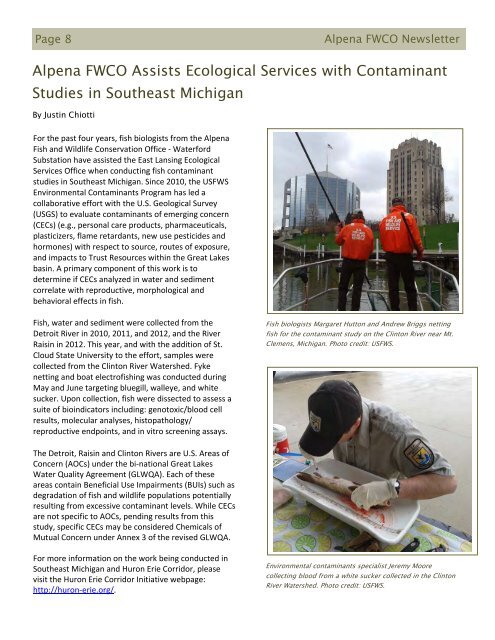July - U.S. Fish and Wildlife Service
July - U.S. Fish and Wildlife Service
July - U.S. Fish and Wildlife Service
You also want an ePaper? Increase the reach of your titles
YUMPU automatically turns print PDFs into web optimized ePapers that Google loves.
Page 8<br />
Alpena FWCO Newsletter<br />
Alpena FWCO Assists Ecological <strong>Service</strong>s with Contaminant<br />
Studies in Southeast Michigan<br />
By Justin Chiotti<br />
For the past four years, fish biologists from the Alpena<br />
<strong>Fish</strong> <strong>and</strong> <strong>Wildlife</strong> Conservation Office ‐ Waterford<br />
Substation have assisted the East Lansing Ecological<br />
<strong>Service</strong>s Office when conducting fish contaminant<br />
studies in Southeast Michigan. Since 2010, the USFWS<br />
Environmental Contaminants Program has led a<br />
collaborative effort with the U.S. Geological Survey<br />
(USGS) to evaluate contaminants of emerging concern<br />
(CECs) (e.g., personal care products, pharmaceuticals,<br />
plasticizers, flame retardants, new use pesticides <strong>and</strong><br />
hormones) with respect to source, routes of exposure,<br />
<strong>and</strong> impacts to Trust Resources within the Great Lakes<br />
basin. A primary component of this work is to<br />
determine if CECs analyzed in water <strong>and</strong> sediment<br />
correlate with reproductive, morphological <strong>and</strong><br />
behavioral effects in fish.<br />
<strong>Fish</strong>, water <strong>and</strong> sediment were collected from the<br />
Detroit River in 2010, 2011, <strong>and</strong> 2012, <strong>and</strong> the River<br />
Raisin in 2012. This year, <strong>and</strong> with the addition of St.<br />
Cloud State University to the effort, samples were<br />
collected from the Clinton River Watershed. Fyke<br />
netting <strong>and</strong> boat electrofishing was conducted during<br />
May <strong>and</strong> June targeting bluegill, walleye, <strong>and</strong> white<br />
sucker. Upon collection, fish were dissected to assess a<br />
suite of bioindicators including: genotoxic/blood cell<br />
results, molecular analyses, histopathology/<br />
reproductive endpoints, <strong>and</strong> in vitro screening assays.<br />
<strong>Fish</strong> biologists Margaret Hutton <strong>and</strong> Andrew Briggs netting<br />
fish for the contaminant study on the Clinton River near Mt.<br />
Clemens, Michigan. Photo credit: USFWS.<br />
The Detroit, Raisin <strong>and</strong> Clinton Rivers are U.S. Areas of<br />
Concern (AOCs) under the bi‐national Great Lakes<br />
Water Quality Agreement (GLWQA). Each of these<br />
areas contain Beneficial Use Impairments (BUIs) such as<br />
degradation of fish <strong>and</strong> wildlife populations potentially<br />
resulting from excessive contaminant levels. While CECs<br />
are not specific to AOCs, pending results from this<br />
study, specific CECs may be considered Chemicals of<br />
Mutual Concern under Annex 3 of the revised GLWQA.<br />
For more information on the work being conducted in<br />
Southeast Michigan <strong>and</strong> Huron Erie Corridor, please<br />
visit the Huron Erie Corridor Initiative webpage:<br />
http://huron‐erie.org/.<br />
Environmental contaminants specialist Jeremy Moore<br />
collecting blood from a white sucker collected in the Clinton<br />
River Watershed. Photo credit: USFWS.
















